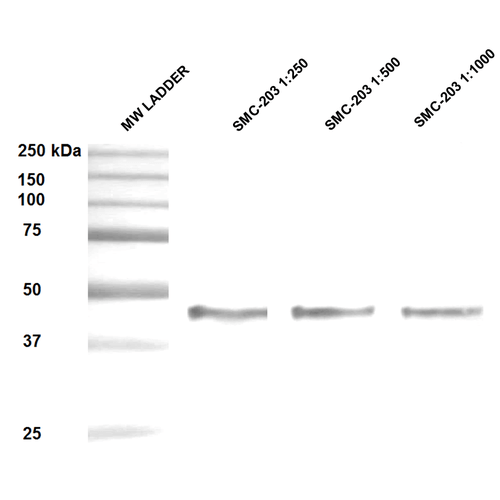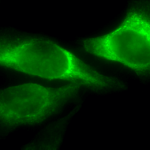Properties
| Storage Buffer | PBS pH7.4, 50% glycerol, 0.09% sodium azide *Storage buffer may change when conjugated |
| Storage Temperature | -20ºC, Conjugated antibodies should be stored according to the product label |
| Shipping Temperature | Blue Ice or 4ºC |
| Purification | Protein G Purified |
| Clonality | Monoclonal |
| Clone Number | 1C4-1A6 |
| Isotype | IgG1 Kappa |
| Specificity | Detects 47kDa. |
| Cite This Product | StressMarq Biosciences Cat# SMC-203, RRID: AB_2699196 |
| Certificate of Analysis | 1 µg/ml of SMC-203 was sufficient for detection of HSP47 in 20 µg of heat shocked HeLa cell lysate by colorimetric immunoblot analysis using Goat anti-mouse IgG:HRP as the secondary antibody. |
Biological Description
| Alternative Names | SerpinH1 Antibody, Colligin Antibody, Gp46 Antibody, serine proteinase inhibitor Antibody, cysteine proteinase inhibitor Antibody, collagen binding protein Antibody |
| Research Areas | Cancer, Cell Signaling, Chaperone Proteins, Heat Shock, Protein Trafficking |
| Cellular Localization | Endoplasmic Reticulum, Endoplasmic reticulum lumen |
| Accession Number | NP_001193943 |
| Gene ID | 871 |
| Swiss Prot | P50454.2 |
| Scientific Background | HSP47 is a chaperone protein, member of the superfamily of serine proteinase inhibitors. Also known as SERPINH1, a serine proteinase inhibitor. It is a stress protein that resides in the endoplasmic reticulum, has an active role on the intracellular process of folding, assembly and secretion of pro-collagens. Recent studies have shown the association of on an increased expression of HSP47 around fibrotic lesions (1). The identification of a novel biomarker on cell therapies aimed to reduce the progression of fibrotic diseases, could be used potentially as a universal marker, since HSP47 binds a single substrate (2). Type I collagen is fundamental during the healing process after a myocardial infarction. It is critical in the position of collagen-produced cells and the assembly of collagen fibrils (3). |
| References |
1. Razzaque MS., Taquchi T., (1999) Histol Histopathol. 14 (4): 1999-212. 2. Taguchi T., et al. (2011) Acta Histochem Cytochem. 44(2):35-41. 3. Nong Z., et al. (2011) Am J Pathol. 197(5): 2189-96. |
Product Images

Immunocytochemistry/Immunofluorescence analysis using Mouse Anti-Hsp47 Monoclonal Antibody, Clone 1C4-1A6 (SMC-203). Tissue: Heat Shocked cervical cancer cells (HeLa). Species: Human. Fixation: 2% Formaldehyde for 20 min at RT. Primary Antibody: Mouse Anti-Hsp47 Monoclonal Antibody (SMC-203) at 1:100 for 12 hours at 4°C. Secondary Antibody: FITC Goat Anti-Mouse (green) at 1:200 for 2 hours at RT. Counterstain: DAPI (blue) nuclear stain at 1:40000 for 2 hours at RT. Localization: Endoplasmic reticulum lumen. Cytoplasm. Magnification: 100x. (A) DAPI (blue) nuclear stain. (B) Anti-Hsp47 Antibody. (C) Composite. Heat Shocked at 42°C for 1h.

Western Blot analysis of Human Epithelial cell (A431) lysates showing detection of ~47 kDa Hsp47 protein using Mouse Anti-Hsp47 Monoclonal Antibody, Clone 1C4-1A6 (SMC-203). Lane 1: MW ladder. Lane 2: Anti-Hsp47 (1:250). Lane 3: Anti-Hsp47 (1:500). Lane 4: Anti-Hsp47 (1:1000). Load: 20 µg. Block: 5% milk + TBST for 1 hour at RT. Primary Antibody: Mouse Anti-Hsp47 Monoclonal Antibody (SMC-203) at 1:250 – 1:1000 for 1 hour at RT. Secondary Antibody: HRP Goat Anti-Mouse at 1:50 for 1 hour at RT. Color Development: TMB solution for 10 min at RT. Predicted/Observed Size: ~47 kDa.

Immunocytochemistry/Immunofluorescence analysis using Mouse Anti-Hsp47 Monoclonal Antibody, Clone 1C4-1A6 (SMC-203). Tissue: Heat Shocked cervical cancer cells (HeLa). Species: Human. Fixation: 2% Formaldehyde for 20 min at RT. Primary Antibody: Mouse Anti-Hsp47 Monoclonal Antibody (SMC-203) at 1:100 for 12 hours at 4°C. Secondary Antibody: APC Goat Anti-Mouse (red) at 1:200 for 2 hours at RT. Counterstain: DAPI (blue) nuclear stain at 1:40000 for 2 hours at RT. Localization: Endoplasmic reticulum lumen. Cytoplasm. Magnification: 20x. (A) DAPI (blue) nuclear stain. (B) Anti-Hsp47 Antibody. (C) Composite. Heat Shocked at 42°C for 1h.


![Mouse Anti-Hsp47 Antibody [1C4-1A6] used in Western Blot (WB) on Human Epithelial cell (A431) lysates (SMC-203)](https://www.stressmarq.com/wp-content/uploads/SMC-203_Hsp47_Antibody_1C4-1A6_WB_Human_Epithelial-cell-A431-lysates_1-100x100.png)
![Mouse Anti-Hsp47 Antibody [1C4-1A6] used in Immunocytochemistry/Immunofluorescence (ICC/IF) on Human Heat Shocked cervical cancer cells (HeLa) (SMC-203)](https://www.stressmarq.com/wp-content/uploads/SMC-203_Hsp47_Antibody_1C4-1A6_ICC-IF_Human_Heat-Shocked-HeLa-Cells_20x_Composite-100x100.png)




















Reviews
There are no reviews yet.